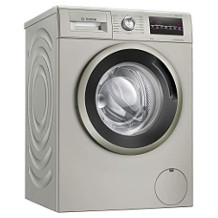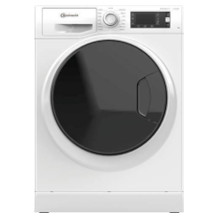Washing machine purchasing advice: how to choose the right product
- What You Need to Know
- Basically, there are two types of washing machines: front loaders and top loaders. Front loaders have a very high market share.
- To save energy and water when washing, it is important to use a washing machine with an appropriate rated capacity.
- The EU energy label provides information on important key figures such as electricity and water consumption and makes it possible to compare the different models.
- Functions such as an imbalance control or safety features such as Aquastop or a child safety lock are indispensable.
- Regular cleaning and descaling is neither time- nor effort-consuming and considerably increases the life of the machine.
Indispensable in almost every household: washing machines
Whether it’s a single household, a small family, a large family or a shared flat – there is one thing that no household has been without for generations: the washing machine. Nowadays, it is unthinkable for most people to do the laundry by hand. Many probably don’t even know how to do it at all.
The first patent for a machine that was used, among other things, to clean textiles, dates back to 1691. The Englishman John Tyzacke applied for it and thus started a slow but unstoppable development. Electric washing machines were manufactured on an industrial scale in New York and Chicago from 1907. Fully automatic washing machines began to conquer private households in the USA in 1946 and in Germany in 1951. In the 1960s and 1970s, the appliances became so cheap that they were also affordable for the broad mass of the population.
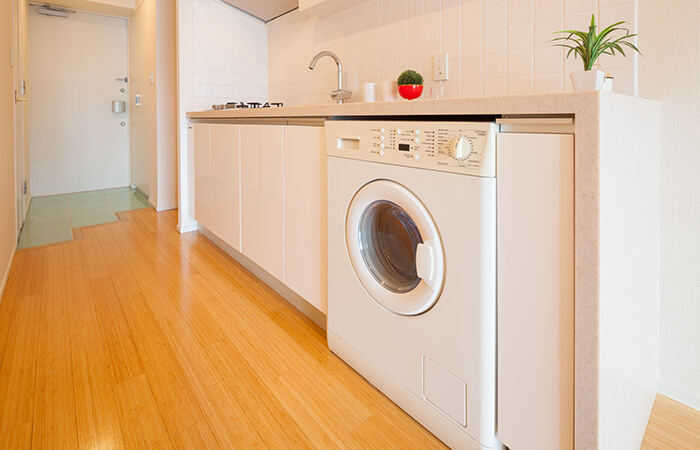
While only about 30 per cent of people worldwide have access to a washing machine, in Germany a proud 96.4 per cent of private households had this practical appliance in 2017, according to a survey by the Federal Statistical Office. This makes washing machines the second most popular large household appliance in this country after refrigerators.
Anyone who has ever had to get by without a washing machine for a longer period of time will understand why the appliances are so widespread. The only practical alternative to having your own washing machine would be to go to the nearest launderette. In contrast, buying your own machine has numerous advantages:
- No journey to and waiting time at the launderette.
- No need to transport the items to be washed
- Acquisition costs are quickly amortised compared to washing costs at the laundromat
- Laundrettes are usually only found in larger cities
Top or front loader? Types of washing machines
Basically, there are two different types of washing machines in terms of construction. These are front-loading and top-loading washing machines. The distinction refers to the position of the opening through which the washing machine is filled: In front-loaders the opening is at the front, in top-loaders it is at the top. Both types have specific advantages and disadvantages and are not suitable for every installation situation.
Front-loading washing machines
With a market share of almost 90 percent, front loaders are by far the most frequently sold type of washing machine in Germany. If you have enough space for the mostly 60-centimetre-wide, 60-centimetre-deep and 85-centimetre-high appliances in your bathroom or kitchen, you should go for a front-loader. We give this advice in good conscience because of the many advantages this type of appliance has over top-loaders. Due to the large market share, there is a wider variety of models and thus a greater choice.
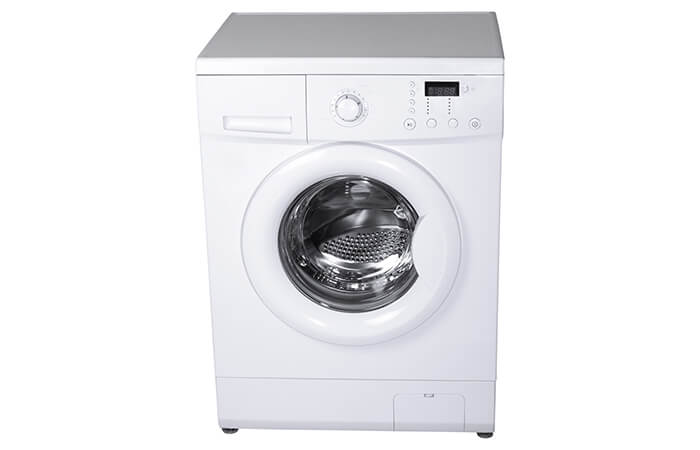
The appliances have a higher capacity than top-loaders, at six to nine kilograms, they run more quietly because of their wider stance, they offer a wider selection of different wash programmes, more functions and options, and their tops can either be used as storage surfaces or the appliances are submountable and thus fit under the worktop of a kitchen unit, for example. Under-mountable means that the cover can be unscrewed to reduce the height of the washing machine exactly enough to fit under a worktop 85 centimetres high.
Can every front-loading washing machine be installed underneath?
Although almost all front loaders have removable covers, there are still some models that have components inside the cover. In order to be able to submount such appliances, the consumer needs a separate submount panel to protect the top of the appliance. Appliances that can be submounted without any problems are marked with a corresponding indication in the appliance description. Beforehand, however, it is important to ensure that the kitchen worktop is actually at a height of 85 cm. If it is lower, even undercounter appliances cannot be fitted.
There are only a few disadvantages to these advantages: Once a cleaning programme has been initiated, it is not possible to interrupt it and open the door to add more laundry. In this case, the water already in the washing machine would leak out. To load and unload, the user must either bend down or get on his knees. Because the suds are in constant contact with the rubber seal during the washing process, front loaders are more prone to leaking than top loaders. However, well-equipped front loaders are comparatively inexpensive. Overall, appliances of this type range in price from about 250 to 2,800 euros.
Pro Points
- Well suited for underfloor installation
- Usually larger capacity (6 to 9 kilograms)
- More wash programmes
- Runs more quietly
- High stability
- Top side can be used as a shelf or can be underbuilt
- Wider choice of models
Drawbacks
- Wider (usually 60 cm)
- Cannot fit in narrower bathrooms
- Can only be loaded in a stooped position
- Interrupting and adding laundry not possible
- More susceptible to suds leakage if rubber seal is defective
Top-loading washing machines
The disadvantages of top-loading machines outweigh the disadvantages, but for many they have a decisive advantage: with a width of only 40 to 45 cm, they are significantly narrower than front-loaders and therefore also fit into smaller bathrooms. But top loaders are also more suitable than front loaders for some consumers for other reasons. For example, older people or people with knee or back problems will appreciate the fact that top loaders can be filled while standing. The fact that the rubber seal is on the appliance’s flap and is not constantly in contact with water also makes these models comparatively leak-proof.
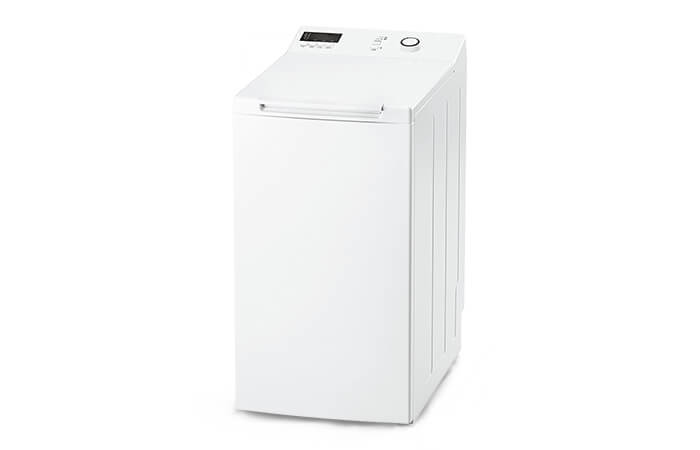
And who has never turned on the washing machine only to realise immediately afterwards that they have forgotten an item of clothing that should also be in the wash? With top-loaders, this is no problem: the washing process can be easily interrupted at any time to add more laundry. In top-loaders, the washing drum is suspended horizontally and rotates vertically. This makes the appliances less prone to becoming unbalanced.
However, top loaders also have some disadvantages. Due to the small standing width, they are less stable, which results in choppier operation and more noise during fast wash and spin cycles. With a capacity of four and a half to seven kilograms, they cannot compete with front loaders. They cannot be underbuilt and the flap must always remain free. The top cannot be used as a storage surface, and there must always be at least 40 cm of free space above the washing machine so that the user can open it. Since only about ten per cent of all new appliances sold are top-loaders, the choice of models is limited and, with prices between 350 and 1,400 euros, the appliances are usually more expensive than front-loaders.
Pro Points
- Narrower (usually 40 cm)
- Suitable for narrow bathrooms
- Can be loaded standing up
- Leak-proof
- Can be reloaded during the washing process
- Unit less likely to be out of balance
- Longer life due to double drum bearings
Drawbacks
- Cannot be placed underneath or pushed underneath
- Lower capacity (4.5 to 7 kilograms)
- Usually runs more unsteadily
- Usually fewer cleaning programmes
- Top side must remain free
- Smaller product selection
- No viewing window
- Comparatively expensive
Special form of washer-dryer
With front loaders, it is of course possible to place a dryer on top of the washing machine and combine the two appliances to form a washing tower. However, if that is too much for you, you can also opt for a washer-dryer. This is a device that is very similar to an ordinary front-loading washing machine, but combines the functions of a washing machine with those of a tumble dryer. Although these are space-saving compared to stand-alone appliances, they do not come close to the technical standard of stand-alone appliances in either functional area.
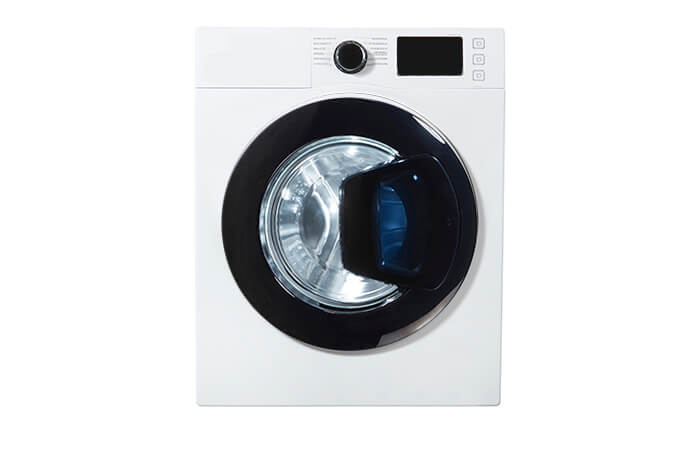
In addition, with a single appliance it is not possible to wash a load of laundry at the same time as drying another load.
Pro Points
- More space-saving than two individual appliances
- No need to move laundry into the dryer
- Cheaper than two single machines
Drawbacks
- Washing and drying not possible at the same time
- High energy consumption
- Lower loading capacity for drying than for washing
- Drying takes longer than with a single appliance
How large must the capacity be?
Another important criterion is the capacity, also known as the rated capacity for washing machines. Washing machine manufacturers specify the nominal capacity in kilograms. The weight specification refers to dry laundry in the normal cotton washing programme. Other programmes, such as wool, easy care, mixed laundry or sportswear, are designed for smaller amounts of laundry.
Why is the choice of the appropriate nominal capacity relevant?
Clearly, the larger the capacity, the more laundry the user can clean in one wash cycle. If the nominal capacity is chosen too large for the actual demand and the user therefore often only half loads it and rarely uses the full volume, the washing machine will consume more electricity than a model with a smaller load capacity.
Idling is expensive!
Tests have shown that front-loading machines in the 40-degree cotton programme consume on average almost three times as much electricity and water per kilo of wash load when the drum is only slightly full, compared with full utilisation of the rated capacity. So filling the drum completely always pays off!
If, on the other hand, the capacity is too small, the user will have to use the washing machine several times to cope with the laundry load. This not only takes more time, but also results in higher electricity and water consumption. If the user overloads the machine, not only will the washing result be worse, but it may even happen that the washing machine no longer spins properly. In the worst case, this can lead to bearing damage.
How do I choose the right nominal capacity?
Top loaders generally have a load capacity of five to seven kilograms, front loaders six to nine. However, there are also appliances on the market with a capacity of ten or twelve kilograms, as well as washing machines with a smaller capacity of only three or four kilograms.
The appropriate size for a household depends primarily on the number of people who will be using the machine at the same time. In a single household, for example, there is significantly less laundry than in a family with two small children. In shared flats, many people typically use the same washing machine, but usually separately. So despite a high overall laundry load, a small washing machine may well pay off. On the other hand, even a small capacity may be too small for a single household if that person has a particularly high laundry load, for example, for work reasons or due to frequent sporting activities.
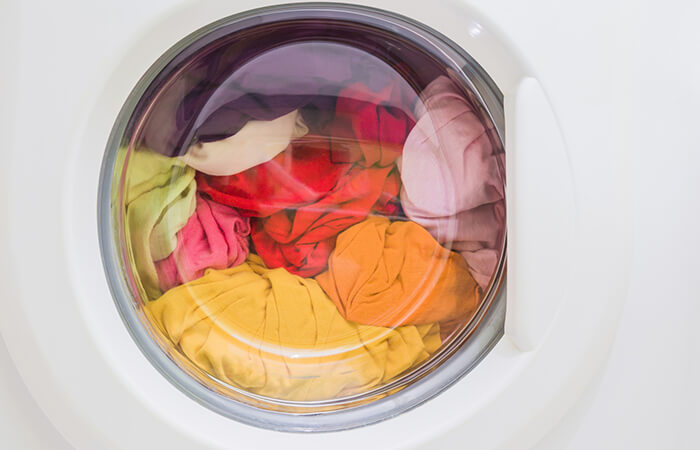
Interested parties need to ask themselves the following questions:
- How many people will be doing their laundry at the same time?
- How often do these people want to wash?
- Do one or more of these persons have a high laundry volume due to professional or recreational reasons?
- Are large textile products such as curtains, carpets or bed covers to be washed more often?
Accordingly, it is not possible to derive a generally applicable key. However, we offer the following conversion table as a rough guide to illustrate which capacity typically seems appropriate for which type of household:
| Nominal capacity | Household size in persons | Typically suitable for … |
| 5 kg | 1 or 2 | single household, couples with low laundry load |
| 6 kg | 2 or 3 | average household |
| 7 kg | 3 or 4 | High-volume family |
| 8 kg | 4 or 5 | Larger family with high laundry volume |
| 9 kg | More than 5 | large families |
Energy efficiency classes for washing machines
What every consumer should pay attention to when buying a new washing machine is the energy efficiency. The EU energy label provides a good basis for comparison.
The EU energy label for washing machines
The current form of the EU energy label (also called EU label, energy label or energy label) for washing machines has existed since 2011. Since the beginning of 2015, the label has also been mandatory in online retailing as legally required consumer information. The values on the energy label refer to a standard washing programme, usually at 60 degrees washing temperature, which is carried out 220 times per year. The basis of the calculation is therefore an assumed operation four times a week.
Class A+++ washing machines have been available since 2012. This is still the best possible energy efficiency class. Since 2013, the energy efficiency classes B to D have been obsolete, as appliances in these classes are not allowed to be put on the market. Currently, A+ is the worst class still permitted for new appliances. The following factors are included in the calculation of the energy efficiency class:
- Energy consumption for 60-degree wash programme with full load
- Energy consumption for 60-degree wash programme with partial load
- Energy consumption for 40-degree wash programme with full load
- Energy consumption with 40-degree wash programme at partial load
- Energy consumption at rest switched on
- Energy consumption at rest switched off
Washing machines in energy efficiency class A++ consume about 12 percent less kilowatt hours of electricity than those in class A+. An appliance in class A+++ saves about 20 percent energy compared to one in class A+.
The label contains the following information:
- Name of the manufacturer and brand name as well as name of the model.
- Energy efficiency class from A+ to A+++
- Coloured bars to show the classes that are already obsolete from A downwards.
- Electricity consumption per year for 220 wash cycles in kilowatt hours
- Water consumption per year for 220 washes in litres
- Nominal capacity of the washing machine
- Spin-drying performance class, also known as spin efficiency class, which indicates the residual moisture in the laundry after spinning on a scale from A (less than 45 percent residual moisture) to G (90 or more percent residual moisture)
- Indication of noise emission during washing (top) and spinning (bottom), both in decibels
- Number of the underlying EU regulation
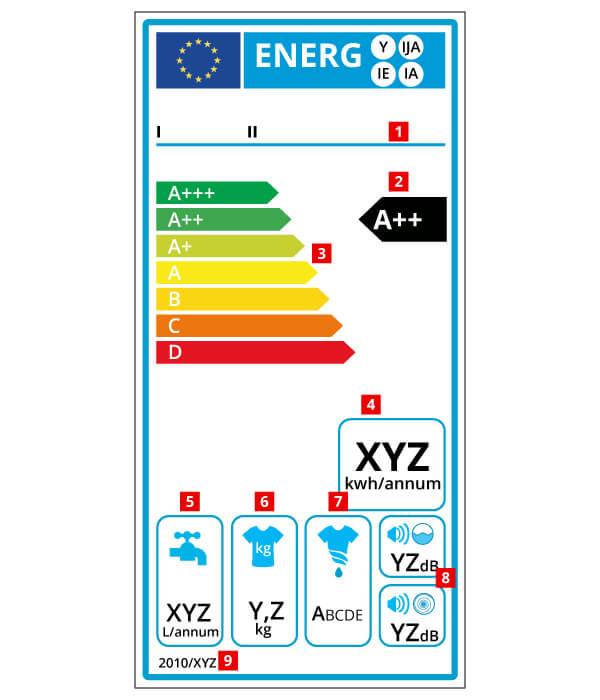
What should I look for when comparing label values?
In addition to the pure energy consumption, the label also provides information about the water consumption of the washing machine. However, the value only refers to consumption in the standard programme. Other washing programmes and additional functions have a completely different water consumption. For example, it increases with an extra rinse cycle or the prewash programme. An eco programme, on the other hand, consumes less water and energy.
For people who dry their laundry with a tumble dryer after washing, it also makes sense to compare the spin-drying performance class, because the drier the laundry comes out of the spin cycle, the less energy the dryer needs to handle the residual moisture. But a comparison of this value is also important for people who air-dry their laundry. The better the spin performance, the faster you can take the laundry off the line again.
If the washing machine is located in the home and not in the basement, consumers should pay attention to the lowest possible noise emission during washing and spinning. Some machines now even offer separate quiet programmes. Values of 50 decibels for washing and 70 decibels for spinning are considered particularly quiet. 50 decibels is roughly equivalent to the sound of birdsong or soft radio music, 70 decibels to that of a hairdryer at the hairdresser.
As a general rule, it only makes sense to compare washing machines with the same capacity, because higher-capacity machines naturally require more energy and water than smaller machines. If you still want to compare appliances with different capacities, divide the numerical value of the energy consumption by the kilogram of the capacity and you get a quotient that indicates the electricity consumption per kilogram of laundry. The quotients are comparable regardless of the machine size.
Example calculation to compare machines with different capacities
Machine A: 158 kWh/annum energy consumption, 8 kilogram capacity; this means 19.75 kWh per kilogram laundry per year
Machine B: 121 kWh/annum energy consumption, 6 kilogram capacity; this means 20.17 kWh per kilogram of laundry per year Conclusion:
Machine A is more energy efficient
Comfort and safety: What technical features are important?
The basic technical principle according to which washing machines work is always identical. After filling the machine with laundry, detergent and fabric softener, selecting the desired programme and pressing the “Start” button, it does everything without further intervention.
In the first step, the machine saturates the laundry with heated detergent solution. An electric motor moves the drum and ensures that all items of laundry are soaked. By alternately rotating in both directions, the washing machine continuously loosens the laundry during the washing process and creates mechanical friction. In the next step, the machine pumps out the suds with the suds pump and rinses the laundry with clean water. Once this has been pumped out, the spin cycle starts at high speed to remove as much moisture as possible from the wash load.
Which additional technical features are useful?
In addition to standard washing programmes, modern washing machines naturally have a lot more to offer. We show which additional features many machines now have and why they make sense.
Automatic load control and load sensor
Automatic load control actively helps consumers to save water and energy by automatically adjusting the amount of water to the load. So if there is less laundry in the drum, the machine also uses less water and spends less energy to heat this water. Load sensors are used to determine the load weight in the drum as accurately as possible. The washing machine shows this weight on a display so that the user can easily assess whether he should add more laundry to save more energy and water. If the load display is extended to include a dosage display, the display also shows which amount of detergent is sufficient for the respective amount of laundry.
Start time preselection and remaining time display
This feature is especially useful for working people. Via a selection, they can specify the start or end time for the different washing programmes. The washing machine then automatically starts the washing process, which should end, for example, exactly when the user comes home from work. The consumer can then take the laundry out immediately after it has finished. Immediate removal from the washing machine prevents the laundry from creasing. The remaining time display serves the same purpose: a display shows the user how much time the selected washing programme still needs to complete.
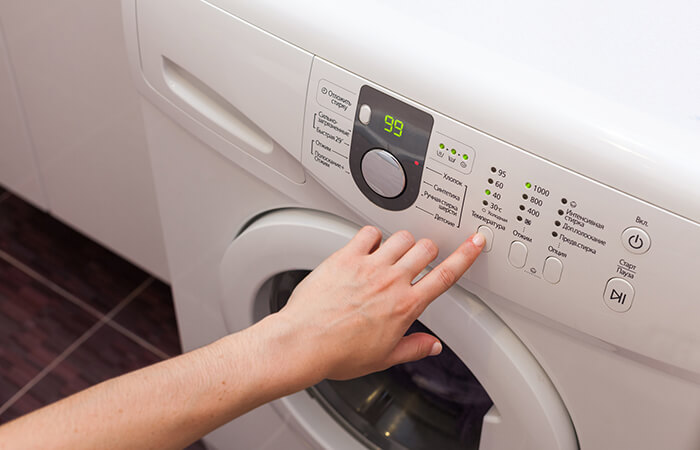
Aquasensor
The aqua sensor is used to automatically optimise and adjust the wash programme. This works by analysing the degree of soiling of the pumped-out suds. If the suds are very dirty, the washing machine automatically increases the number of rinse cycles or extends their duration.
Unbalance control
The unbalance control function is now a standard feature of washing machines. An unbalance occurs in the washing drum when the weight of the soaked laundry is unevenly distributed. In the long term, this can lead to wear on the bearings of the washing drum suspension during the spin cycle. In addition, an imbalance manifests itself in unsteady operation: the machine wobbles back and forth, which can be annoying for neighbours in apartment buildings. This cannot happen in a machine with unbalance control, as it distributes the laundry evenly by successively turning the drum slowly before the spin cycle starts.
Aquastop and multiple water protection
Should the inlet hose ever leak or even burst, this feature is worth its weight in gold: it sometimes saves the user from water damage. Aquastop is a protection system located on the water supply hose that interrupts the water supply by means of a shut-off valve if there is a pressure drop in the hose.
The multiple water protection also becomes active if the washing machine itself is leaking. A level switch always registers the water level inside the machine, a float detects a rising water level in the base tub. If the water exceeds a certain level, the machine stops the water supply and pumps out excess water.
Child safety lock
Washing machines fascinate small children with their drum visible through the viewing window and the colourful flashing controls. It is therefore all the more important for households with young children that their washing machine has an electronic child lock. This ensures that children cannot accidentally start the wash cycle or change the programme while the washing machine is running. It locks the programme functions and deactivates the control panel. Most models have a separate button that activates and deactivates the child lock.
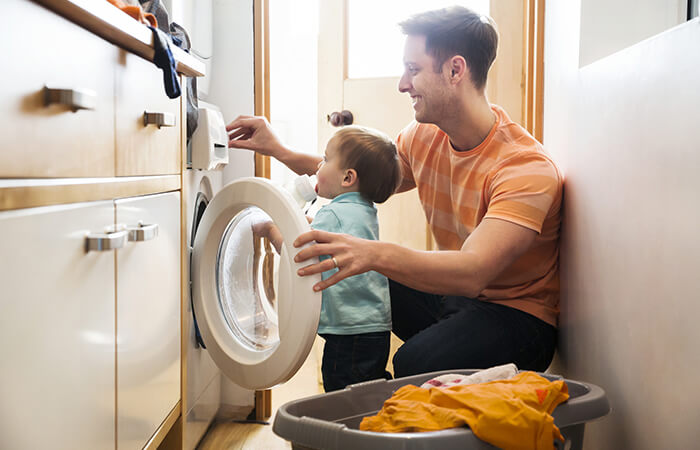
How to clean and maintain a washing machine
Cleaning and maintenance of modern washing machines is nowhere near as time-consuming as it was a few decades ago. If the user carries out a few measures regularly, care requires little time and the machine achieves a long service life.
Cleaning the rubber seal
A little limescale and dirt regularly builds up on the rubber seal of the washing machine, especially in front loaders. In addition, the rubber seals are susceptible to mould growth when damp. It is therefore advisable to remove dirt from the cuff with a damp cloth after each wash cycle and then dry it with another cloth. Chemical cleaning agents are poison for the cuff: they can attack the material, make it brittle and thus cause water damage.
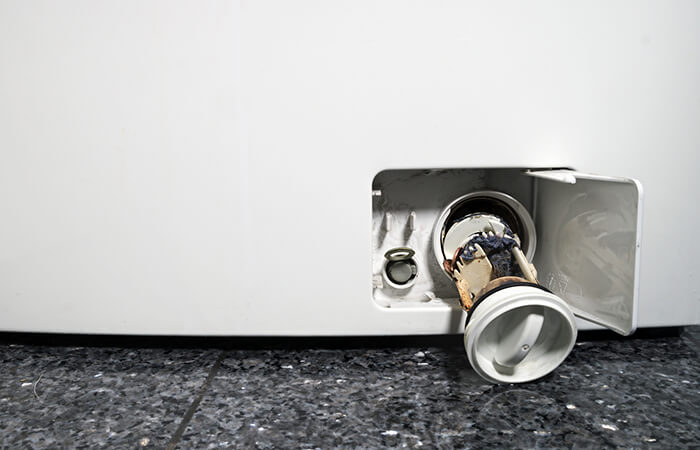
After each wash cycle, it is also advisable to leave the door of the washing machine open. This allows the interior and the rubber seal to dry without causing odours inside the washing machine.
Cleaning the detergent drawer
Over time, detergent residues accumulate in the detergent drawer that could not be completely rinsed into the machine. This leads to the formation of bacteria, which results in unpleasant odours, dirt deposits or mould. In the worst case, these deposits settle in the washing machine or on the laundry. It is therefore advisable to clean the drawer regularly with a damp cloth at intervals of a few months. In case of stubborn dirt, the use of vinegar is advisable. Some drawers are completely removable and dishwasher-safe, so users can clean them in this way. For this, a look at the user manual of the respective model is advisable. If the drawer is removable but not dishwasher safe, the user soaks it in a bucket of water for some time before cleaning to remove stubborn dirt.
Cleaning the lint filter
If the lint filter is clogged with fibres, this will result in an unpleasant smell coming from the machine and on the laundry. Objects forgotten in the laundry, such as lighters or small change, can also get into the lint filter and clog it. Some appliances react with an error message and a blockage of the appliance door. In most cases, the washing machine no longer pumps out the water and the spin cycle does not start.
If this problem occurs, the user opens the flap at the base of the appliance, lets the residual water run out of the machine through the drain hose into a container and then unscrews the lint filter. Clean it under lukewarm running water. After the filter and the rubber seals have been completely cleaned, he screws it back in and starts the machine up again. To prevent excessive soiling, it is advisable to carry out this cleaning as a six-monthly routine.
Boil wash cycle
In the interest of energy-saving washing, washing machines today operate primarily with low water temperatures. Detergents also work under these conditions, but some agents do not dissolve completely. It is therefore advisable to run a boil wash cycle at regular intervals with the washing drum empty. This dissolves all detergent deposits in the washing machine and in the pipes. This minimises odours and prolongs the life of the machine.
Descaling the machine
Depending on the hardness of the water, it may be necessary to descale the machine at regular intervals using descaler, vinegar or citric acid.
Descaling is worthwhile!
If the machine is calcified, it consumes up to 30 percent more electricity, can suffer electrical damage or cause water damage. The first indication is usually that the laundry no longer gets clean because the calcified heating elements no longer produce the desired washing temperature.
The user should first ask the responsible water company about the hardness of the water in his or her region. If this value is below 4, the machine should be descaled every six months. If the value is higher, it is advisable to add a descaler tab or descaler powder to each wash.
The descaling process is simple:
- Put descaler in the detergent compartment or in a ball in the machine
- Set the highest temperature
- Start wash cycle without laundry with descaler
- Stop the machine during the process or set it to “soak”.
- Finish the wash cycle normally
What do I need to know when washing with the washing machine?
Once the new washing machine is installed in your own four walls, that’s not the end of the story. It is by no means always self-explanatory how to operate the machine, which of the many programmes is suitable for which purpose, which detergent is suitable for which temperatures and which clothes, and which item of clothing may be washed.
Which washing programme is suitable for what?
Control panels of modern washing machines are usually equipped with several buttons or a rotary switch that are used to select the washing programme. The programmes are usually structured according to the type of textiles to be washed and other parameters, such as the desired washing temperature. In addition, there are other buttons or switches for various additional functions, such as quick wash programme, prewash or additional rinse. The range of possibilities and combination options is constantly expanding.
There are now numerous special wash cycles that can be combined with special functions, such as a separate programme for pet hair removal. The panel also contains other buttons for selecting the spin speed, temperature setting, start time selection or additional options. A display shows details of the programme selection and the programme sequence visually.
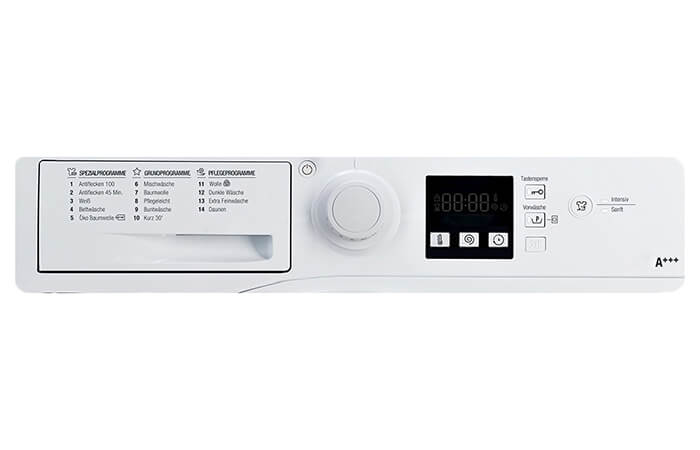
Displays should provide the following information:
- Remaining time of the washing programme
- Start time display
- Indication of the currently selected programme
- Status of the child lock
- Display at the end of the programme
Standard programmes

Standard programmes, often referred to as main programmes, usually consist of a combination of fabric type, colour or eco-wash cycle with the desired wash temperature. Examples are cotton 40 degrees, boil wash/colour wash, easy-care laundry and wool. A modern washing machine can thus quickly come up with up to 20 standard washing programmes in combination with the temperature levels 30, 40, 60 or 90 degrees Celsius.
Special programmes
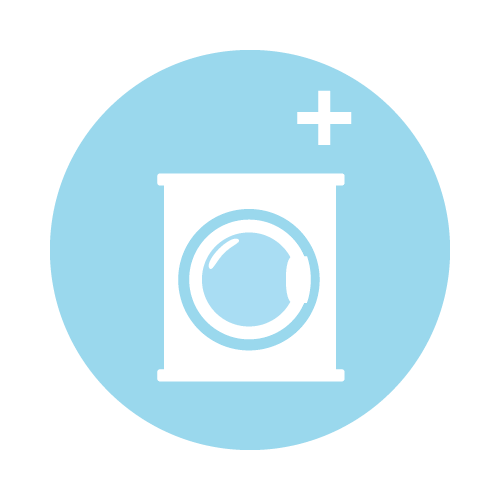
Special programmes supplement the standard programmes by specifying them. They are tailored to certain fabrics or degrees of soiling, such as dark textiles, lightly soiled cotton laundry or baby clothes. For particularly delicate items, for example, there is a “hand wash” programme or the so-called “mix” programmes (for mixed fabrics of cotton and synthetics).
Quick programmes
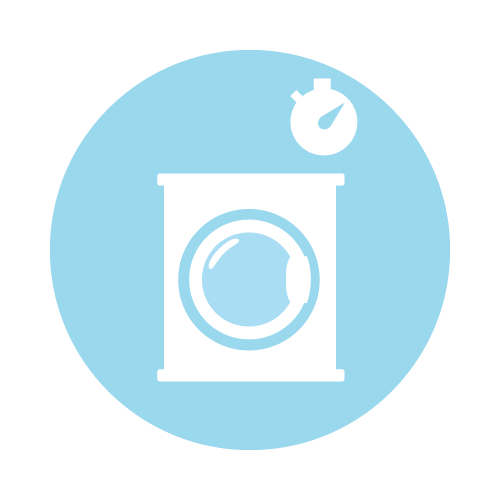
These programmes, often referred to as short programmes or “Express” or “Super Express” in the washing machine’s programme selection, are designed for the quick washing of small quantities of lightly soiled textiles. The washing time is usually less than 30 minutes and the maximum washing temperature is 30 degrees Celsius.
Energy-efficient programmes

Energy-saving, eco or ECO programmes are very much in vogue and are being expanded all the time. Compared to standard programmes, these programmes save water and energy. As with standard programmes, the more the machine is filled to capacity, the greater the savings. Eco programmes take longer than standard wash cycles because they work at lower temperatures and instead allow the laundry to soak in the water for longer.
What detergents are there and what are they suitable for?
The user puts detergent and fabric softener in three separate compartments. In front loaders, these are in a drawer on the front, in top loaders on the inside of the flap. The type and quantity of detergent does not depend on the washing machine, but on the type and quantity of textiles to be washed. A distinction is made between heavy-duty detergents, coloured detergents, mild detergents and fabric softeners.
Heavy-duty detergent

They are suitable for almost all types of laundry at all washing temperatures. However, as heavy-duty detergents contain bleaching agents and optical brighteners, they should not be used for sensitive, coloured textiles. For them, coloured or delicate detergents are the better choice. Heavy-duty detergents are ideal for white and heavily soiled textiles at washing temperatures of 30 to 95 degrees Celsius.
Coloured detergents
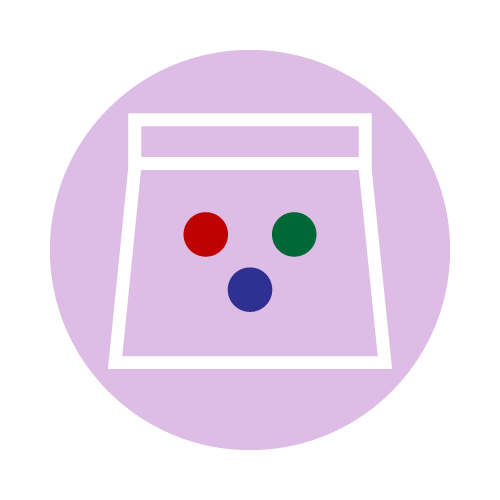
In the temperature range from 20 to 60 degrees Celsius, multicoloured detergents are the best choice for wash loads with different coloured textiles. They prevent mutual discolouration, but cannot guarantee complete colour retention.
Delicates detergent

Fine detergents are a special solution, just like special detergents or detergents for special water hardness. They are suitable for delicate fabrics for wash cycles at 30 degrees Celsius. Silk, wool, functional textiles, fine tights and textiles made of cellulose fibres, such as lyocell and viscose, always require mild detergents.
Fabric softener

Fabric softeners are now an integral part of almost every wash cycle. They prevent the clothes from drying out, making them softer and easier to iron. In most cases, these additives also give the laundry a more discreet scent. In synthetic fabrics, fabric softener reduces the electrostatic charge between the fibres. It is not advisable to use fabric softeners when washing towels or tea towels. They lose absorbency and water absorption capacity due to the fabric softener, which protects the fibres.
What do the washing instructions on the clothes mean?
Before washing new clothes, the question often arises: What care does this particular textile require? In order to protect the colour and structure of the fabric as much as possible during cleaning, it is advisable to use the washing symbols as a guide. These are standardised for the countries of Europe, Israel, the USA and Japan.
The up to five washing symbols are usually found (always in the same order) on a white patch in the left inner seam. The following sequence and symbols apply:
- Washing bowl: Washing
- Triangle: Bleach
- Square: Drying
- Iron: Ironing
- Circle: Dry cleaning
Washing
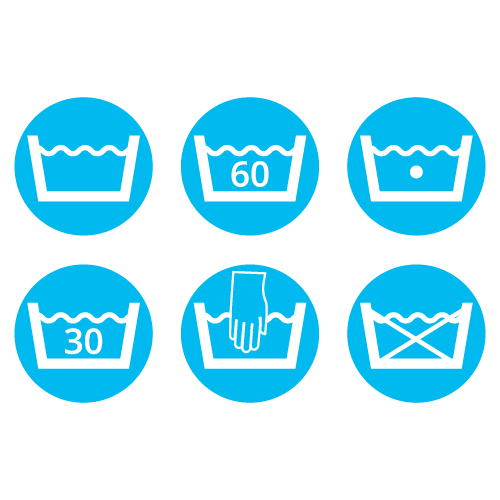
The number in the laundry basket indicates the maximum washing temperature. Here, “30°” means that the laundry should be washed at a maximum of 30 degrees Celsius. There is an alternative notation where dots are used: One point corresponds to 30 degrees, two points to 60 degrees and three points to 90 degrees Celsius. The maximum number of spins is possible if there is no horizontal line under the laundry basket symbol. One dash means “spin gently” and two dashes are a no-spin. A hand in the water indicates hand wash, and if the symbol is crossed out, there is unfortunately only one thing left to do: do not wash! Only dry cleaning can help here.
Bleach

This washing symbol, a triangle, is always in second place. An empty triangle allows bleaching. If there are two parallel lines in it, only bleaching with oxygen is allowed. If it is crossed out, the textile must not be bleached.
Drying

A square with a circle inside indicates that the garment can be dried in a tumble dryer. One dot indicates gentle drying, two dots indicate very gentle drying and three dots indicate extremely gentle drying. A crossed-out symbol means: Do not use a dryer!
Ironing

The symbol is relatively self-explanatory. Crossed out means ironing is prohibited. One dot allows ironing at a maximum of 110 degrees. Two dots draw the temperature limit at 150 degrees and three dots at 200 degrees.
Chemical purification

A circle symbolises professional cleaning. If there is no other indication, the cleaning company decides how to proceed. If the circle is crossed out, the garment must not be cleaned. “F” refers to cleaning with hydrocarbons, “P” to the use of the solvent perchloroethylene and “W” to so-called wet cleaning. One or two horizontal lines under the cleaning symbol indicate gentle or very gentle cleaning.

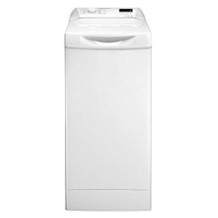
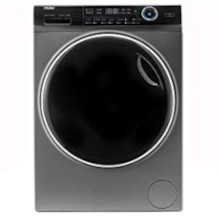
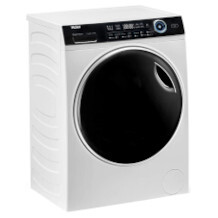
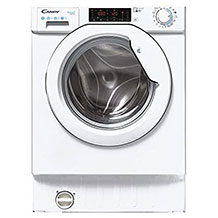
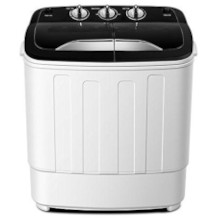
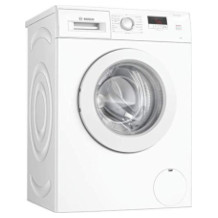

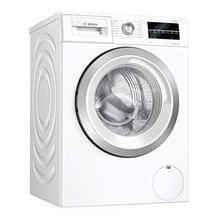
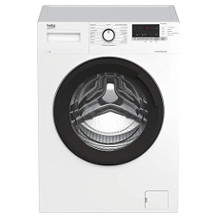
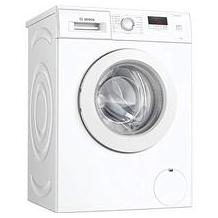
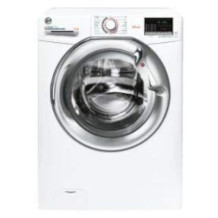
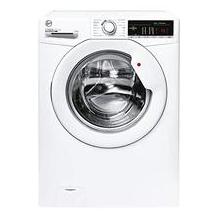
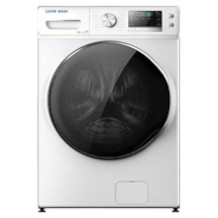
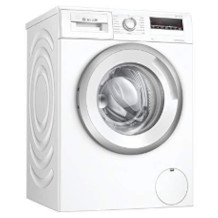

 978 reviews
978 reviews
